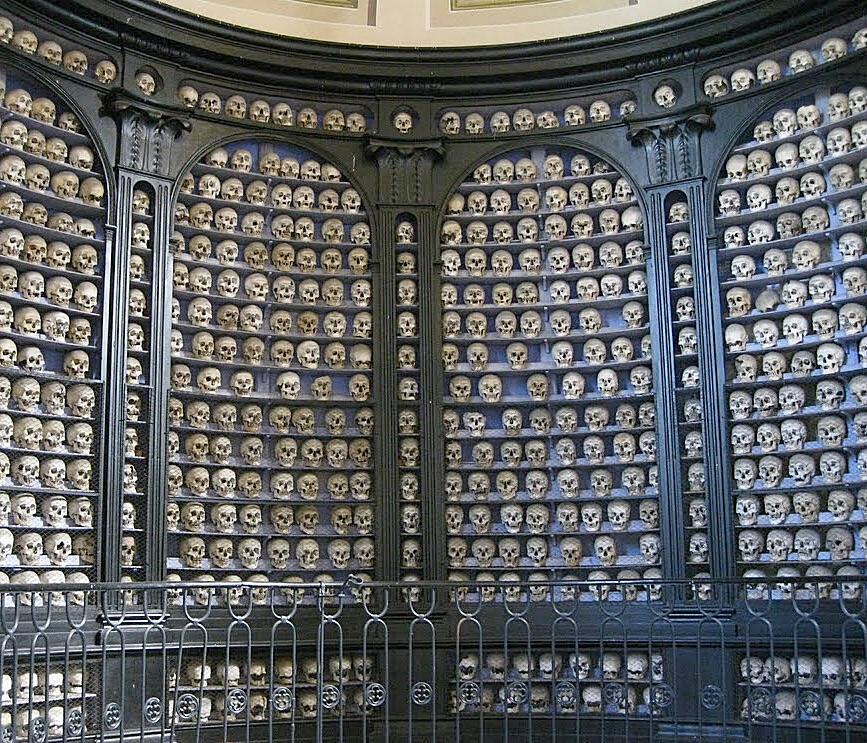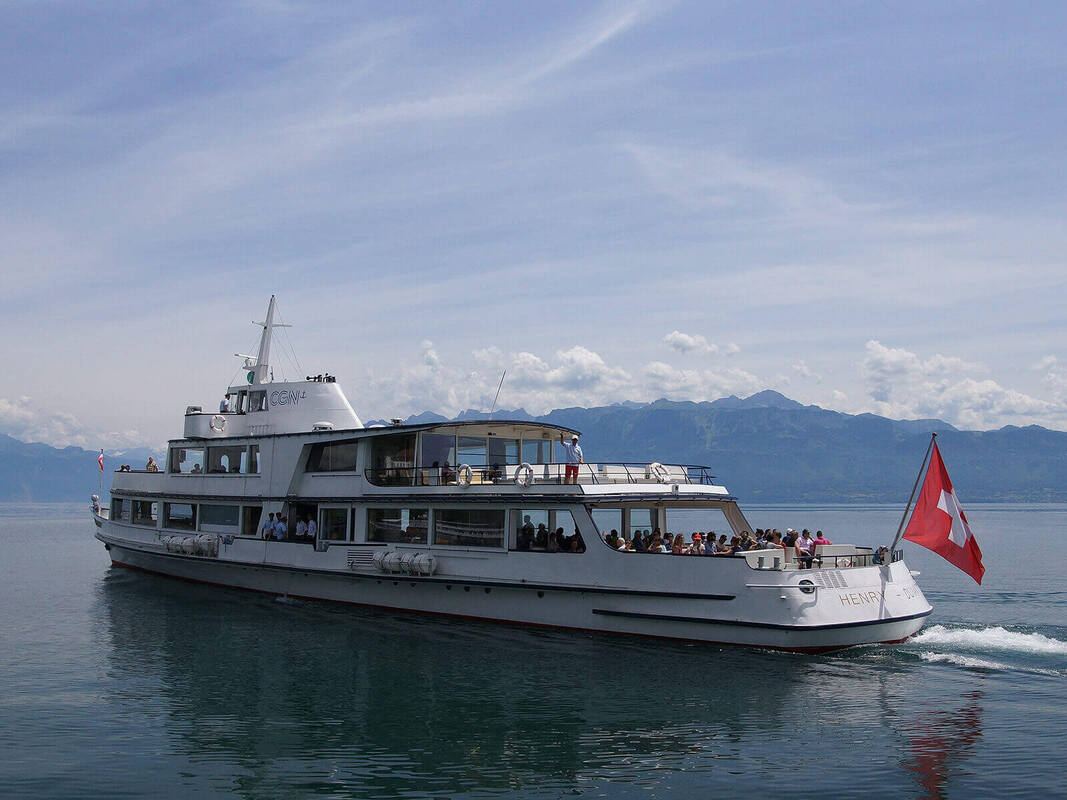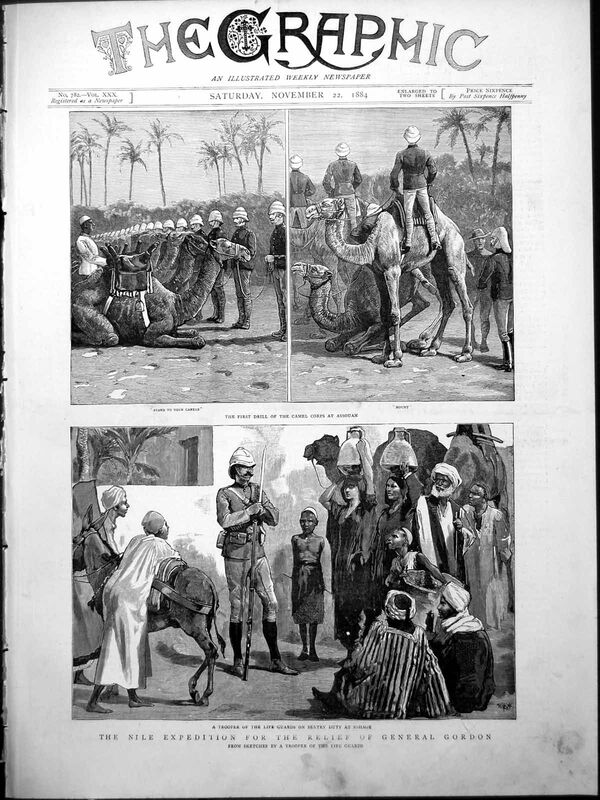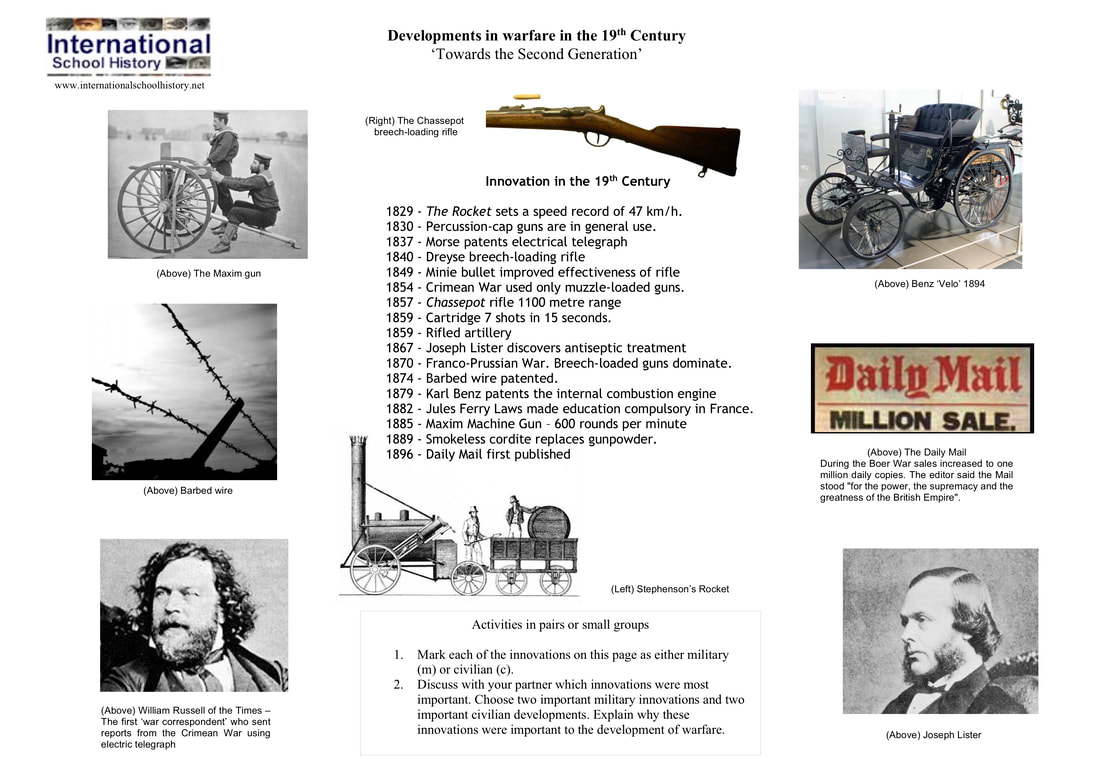Lesson 7 - 19th Century Industrial War
Big questions and some more answers
In the last lesson we once again addressed some of those big questions about warfare that we set out at the start of this unit. The Napoleonic Wars marked a significant turning point in the history of warfare, the end of limited war and the beginning of wars fought between nation states. These wars also reflected how new ideas like liberty and nationalism - rather than just religion - could inspire people to fight. We saw also how the commemoration of war can also be used to help create national feeling. The Arc de Triomphe in Paris was built as a memorial to Napoleon's victories and his generals, but today it means so much more to the French. We also saw how the way war was fought reflected changes in society. Napoleon became an important general because of his ability, not because of his social status. The French Revolution had made governments fear what the ordinary people might do. So we saw how the Napoleonic Wars were the first wars in which the state tried to control what people were thinking through the use of propaganda.
In the last lesson we once again addressed some of those big questions about warfare that we set out at the start of this unit. The Napoleonic Wars marked a significant turning point in the history of warfare, the end of limited war and the beginning of wars fought between nation states. These wars also reflected how new ideas like liberty and nationalism - rather than just religion - could inspire people to fight. We saw also how the commemoration of war can also be used to help create national feeling. The Arc de Triomphe in Paris was built as a memorial to Napoleon's victories and his generals, but today it means so much more to the French. We also saw how the way war was fought reflected changes in society. Napoleon became an important general because of his ability, not because of his social status. The French Revolution had made governments fear what the ordinary people might do. So we saw how the Napoleonic Wars were the first wars in which the state tried to control what people were thinking through the use of propaganda.
Heritage Objects - The Ossuary at San Pietro and a CGN Boat on Lake Geneva
These heritage objects present a bit of puzzle. What is the connection between a church made up of thousands of sculls near Lake Garda in Italy and CGN boat that sails on Lake Geneva?
A bit of background
In the 19th century, warfare was transformed by the industrial revolution and nationalism. (Matu 4) Steam power, factory manufacturing and developments in the chemical and iron industry transformed Europe from being a largely agricultural, rural society to being an industrial society with a massively growing urban population. The new ideas of liberalism and nationalism (Matu 5) led to the creation of new independent nation states like Belgium (1831), Italy (1861) and Germany (1871). War was to be a significant factor in the creation of these nation states.
The changing nature of warfare - From First to Second Generation War
First generation warfare reflected tactics of the era of the smoothbore musket, the importance of discipline when soldiers fought close to the enemy in lines and columns. These tactics were developed partially in response to technological factors — the line maximized firepower, rigid drill was necessary to generate a high rate of fire, etc. — and partially in response to social conditions and ideas, e.g. low training levels of soldiers who had been forced to fight (conscripted).
Second generation warfare was a response to the development of the rifled musket, breechloaders, barbed wire, the machine gun and the desire to exploit the capabilities of the railway, the telegraph and a fully industrialised economy and literate population. The business of killing had become altogether more efficient. The ‘progress’ in weapon technology allowed for the killing of larger number of enemy soldiers than ever before and transport and communication developments made it possible to assemble and supply larger armies than ever before. More men could be put on the battlefield and more of them could be killed in a shorter period of time. Part of this was made possible by military innovation in, for example, firearm developments, but non-military innovation also played an important role.
In the 19th century, warfare was transformed by the industrial revolution and nationalism. (Matu 4) Steam power, factory manufacturing and developments in the chemical and iron industry transformed Europe from being a largely agricultural, rural society to being an industrial society with a massively growing urban population. The new ideas of liberalism and nationalism (Matu 5) led to the creation of new independent nation states like Belgium (1831), Italy (1861) and Germany (1871). War was to be a significant factor in the creation of these nation states.
The changing nature of warfare - From First to Second Generation War
First generation warfare reflected tactics of the era of the smoothbore musket, the importance of discipline when soldiers fought close to the enemy in lines and columns. These tactics were developed partially in response to technological factors — the line maximized firepower, rigid drill was necessary to generate a high rate of fire, etc. — and partially in response to social conditions and ideas, e.g. low training levels of soldiers who had been forced to fight (conscripted).
Second generation warfare was a response to the development of the rifled musket, breechloaders, barbed wire, the machine gun and the desire to exploit the capabilities of the railway, the telegraph and a fully industrialised economy and literate population. The business of killing had become altogether more efficient. The ‘progress’ in weapon technology allowed for the killing of larger number of enemy soldiers than ever before and transport and communication developments made it possible to assemble and supply larger armies than ever before. More men could be put on the battlefield and more of them could be killed in a shorter period of time. Part of this was made possible by military innovation in, for example, firearm developments, but non-military innovation also played an important role.
Military innovation
|
Three significant developments:
1. Percussion cap. Industrial chemists had discovered fulminate of mercury, an explosive that detonates when struck. 20% of flintlock muskets failed to fire because of the damp and wind. A sealed percussion cap fired whatever the weather. The British army introduced them in 1839 and they helped win the Crimean War against Russia in 1853-56. 2. Minie bullet. A French invention from 1849. When dropped into the muzzle of the gun, it expanded when fired and followed the grooves (rifling) on the inside of the gun barrel. They were accurate up to 600m, five times that of a smooth bore musket. |
|
3. Dreyse rifle. A Prussian (German) invention from the 1840s. The bullet was slotted into a chamber at the base of the barrel (the breech), ready for firing. It could be reloaded five times quicker and from a lying position. They were used by the Prussians for the first time in their successful war against Austria in 1866.
|
From 1885, infantrymen had a magazine-loading rifle that allowed them to fire every four seconds. In addition, cartridges became smaller and lighter so soldiers could now carry more. In the Austro-Prussian war of 1866, soldiers could carry and use 60 rounds by 1914 the figure increased to 200. Artillery also became more efficient. In the 1880s lighter steel improved mobility, new high explosives (TNT, cordite) increased the range so by 1914 artillery had a range of 20 miles and could be fired as often as a rifle.
Perhaps the most significant development during this period was the ‘Maxim gun’: a machine gun capable of firing 600 rounds a minute and light enough to be carried by infantry. (See video right) At the battle of Omdurman 1898, 11000 Sudanese were killed for the loss of 28 Britons. (see Matu 6) |
|
Non-military (civilian) innovation
The first steam railways (1820s) were built to transport material and people that were essential to business. (Matu 4) The military potential of steam engines and steam ships was soon appreciated. As early as 1843 Helmuth von Moltke, chief of the Prussian (German) general staff had argued that ‘every new development of railways is a major military advantage’. Railways were built to move troops to the national borders. The railways not only enabled the mobilisation of larger armies than ever before, equally important was the role of the railways in supplying the army in the field with the resources needed to conduct the campaign. Also important to the conduct of industrial warfare was the development of telegraphic communications that enabled military leaders to coordinate the movements of thousands of troops quickly and accurately.
The first steam railways (1820s) were built to transport material and people that were essential to business. (Matu 4) The military potential of steam engines and steam ships was soon appreciated. As early as 1843 Helmuth von Moltke, chief of the Prussian (German) general staff had argued that ‘every new development of railways is a major military advantage’. Railways were built to move troops to the national borders. The railways not only enabled the mobilisation of larger armies than ever before, equally important was the role of the railways in supplying the army in the field with the resources needed to conduct the campaign. Also important to the conduct of industrial warfare was the development of telegraphic communications that enabled military leaders to coordinate the movements of thousands of troops quickly and accurately.
|
But the development of the telegraph also created a potential problem for governments. Journalist 'war correspondents' were able to provide instant accounts detailing the reality of war. William Russell, a reporter with The Times of London wrote such harrowing accounts of the fighting in the Crimean War that the critical public called out for change. The government responded by strictly controlling the reporting of future wars (censorship) and by carefully manipulating public opinion through official propaganda and through new nationalistic newspapers that encouraged cultural militarism. Significantly improving levels of literacy provided a mass readership for patriotic stories of overseas adventures that glorified war.
But when the enthusiastically patriotic young men applied to join the army, the terrible poverty and conditions of industrial urban living meant that they were often too unhealthy and too poorly educated to be of use to the army. When Britain recruited for the Boer war of 1901, a significant proportion of the would-be soldiers were discovered to be too unfit or malnourished to be able to fight. One of the main motivations behind the European-wide state education and welfare programmes at the end of the 19th century was the desire to have a better-educated and healthier fighting force.
|
Activities
Part 1 - The changing nature of warfare in the 19th century.
Activity in pairs or small groups. Copy and paste the timeline of innovations into your class OneNote. Discuss with your partner which innovations are military and which civilian. Mark your timeline with M for military and C for civilian. Choose one important military innovations and one important civilian developments. Explain why these innovations were important to the development of warfare.
Part 1 - The changing nature of warfare in the 19th century.
Activity in pairs or small groups. Copy and paste the timeline of innovations into your class OneNote. Discuss with your partner which innovations are military and which civilian. Mark your timeline with M for military and C for civilian. Choose one important military innovations and one important civilian developments. Explain why these innovations were important to the development of warfare.
|
1829 - The Rocket sets a speed record of 47 km/h.
1830 - Percussion-cap guns are in general use. 1837 - Morse patents electrical telegraph 1840 - Dreyse breech-loading rifle 1849 - Minie bullet improved effectiveness of rifle 1854 - Crimean War used only muzzle-loaded guns. 1857 - Chassepot rifle 1100 metre range 1859 - Cartridge 7 shots in 15 seconds. 1859 - Rifled artillery 1867 - Joseph Lister discovers antiseptic treatment 1870 - Franco-Prussian War. Breech-loaded guns dominate. 1874 - Barbed wire patented. 1879 - Karl Benz patents the internal combustion engine 1882 - Jules Ferry made education compulsory in France. 1885 - Maxim Machine Gun – 600 rounds per minute 1889 - Smokeless cordite replaces gunpowder. 1896 - Daily Mail first published |




